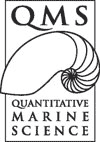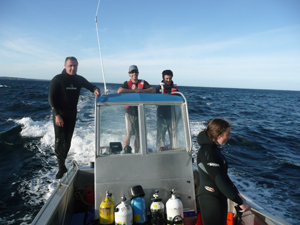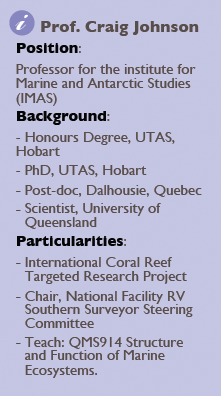

"Would you like to come with us? And see what it is like working in the field?" – Immediately after our interview, University of Tasmania Professor Craig Johnson offered me the opportunity to follow him for two days in the field. This renowned scientist, working at UTAS in Hobart, showed a keen interest in simply sharing his experiences, knowledge, and life. Naturally, I accepted his proposition to travel with a dive crew to St Helens, on Tasmania's east coast and discovered how some kinds of data are collected from the floor of the ocean (available here).
Craig Johnson supervises several QMS students undertaking research projects on the ecology of marine benthic communities. In this interview he explains the research that makes this work so interesting.
 Studying the deep benthos (bottom of the ocean) is a challenge because at any depth beyond diving depth (about 25 metres), we know very little. In Australia it is only very recently we have been able to obtain good quality data in useful quantity from deeper than diving depths. We are using this information to get a handle on some very basic things like the patterns of biodiversity and the dynamics of those systems. For example, these data can tell us how temporally variable these systems are, and provide clues of the mechanisms behind the dynamics?
Studying the deep benthos (bottom of the ocean) is a challenge because at any depth beyond diving depth (about 25 metres), we know very little. In Australia it is only very recently we have been able to obtain good quality data in useful quantity from deeper than diving depths. We are using this information to get a handle on some very basic things like the patterns of biodiversity and the dynamics of those systems. For example, these data can tell us how temporally variable these systems are, and provide clues of the mechanisms behind the dynamics?
Climate change is another major issue to look at. Humans have a significant impact on shallow water which is already more affected by climate change than deeper waters. So, in the coastal zone, management and conservation are big challenges.
You spend a lot of time in the water! The most effective way of getting good data on the urchins is to dive, however last year we also used the Integrated Marine Observing System AUV (Automated Underwater Vehicle) to obtain behavioural and abundance information at depths of 30-40 m. The AUV can work at depth to 100s of metres, and at 30-40 m it's a lot easier than diving. The trouble with using this technology is that there are still urchins down in the cracks and crevasses that we can't see.
I think site-specific sea star removal activities are ok if you want to protect a particular local site. But, as a general means of control of an invasive species once it is established, that method won't work. If you keep taking the sea stars out of a particular area you can keep the population low and that's a good thing because they have a huge environmental impact. However, a community that wants to keep a beach clear has to realise that it's like dusting a house, you have got to do it frequently.
I think we did have an opportunity for reducing risk of further spread. For a long time they were only in the Derwent River. Some years ago, we demonstrated that probably more than 90 % of the reproductive output was coming from animals just around the wharfs and the yacht clubs. That's where the very high densities of highly fecund animals were, where they had lots of food. If there had been a strong focus on the wharfs at that time, we could have had a major impact on larvae production. But that opportunity is now gone and the Northern Pacific sea star is now in high densities in various places on the east coast of Tasmania.
The great strength of the QMS program is that it takes students from all different backgrounds—biogeochemistry, chemical oceanography, physical oceanography, marine biology—and it introduces them to a broad range of quantitative marine science ideas and techniques. I think it's really important for physical oceanographers, for example, to understand the basics of the structure and functioning of marine ecosystems. Conversely, biologists need to understand about physical oceanographic processes as a key driver of ecological dynamics.
The QMS courses are quite short so we can't make modellers or oceanographers in a week or two but what we can do is introduce the concepts, and the kinds of data, models and other technologies that are available, and I think that's really important. Quite a few students in QMS have found it really beneficial for their PhD work when they have completed this broad range of units.
In terms of marine science, the future is in quantitative science and Australia as a nation, like most other places, has not been producing enough quantitative scientists. Models and modelling, and the capacity to make predictions and envisage alternative futures for marine systems, is increasingly important. Global population is going up and up: the UN estimates that by 2050, we will increase from the current 6 billion to something around 9.5 billion people. That is like taking all people alive in about 1960 and adding them to the current lot. The pressure on marine and other environmental systems is going to be huge. Modelling as a way of envisaging possible futures for marine systems under different management and socioeconomic scenarios will be important for fisheries and others kinds of marine management worldwide.
I think it's also a great program to be involved in because of the collaboration with scientists working at CSIRO: it is very good for students and for supervisors because it fosters collaborative networks. The other thing for me is that because the QMS Program is unique, and because we are able to offer special scholarships, we do attract some of the best students from Australia and overseas. It's wonderful from a supervisor's point of view to be able to have access to really top class students and it has been lovely to have the increased infusion of international students.
There are numerous motivations for supervising students. First of all, there are too many questions for one person to tackle and if we really want to make progress, supervising a group of people is a much more efficient and effective way than trying to do it all yourself. As my career develops, I now find myself spending more and more time trying to dream up good ideas, writing applications, getting money and then appointing students and hiring post doctoral research fellows to do much of the work.
At a personal level, I also really enjoy the interaction that I have with students. All my students have been really good, and it is highly enjoyable working in a group dynamic with young, talented and motivated people.
Tasmania's capital, Hobart, has 40 % of Australia's marine and Antarctic scientists and the highest density of marine scientists in the Southern Hemisphere. There is a huge community across CSIRO, the university and the Australian Antarctic Division. There are a lot of very good people that are very happy to work with students. There are not many places in the world that can say that!
I think for anyone who is interested in temperate or Antarctic marine science, I can't see any better place to go. It's absolutely fantastic! I used to work in Queensland on the Barrier Reef (which, or course, was wonderful too). But people said to me: "You must be mad to leave a big 'sandstone' university to go to a smaller place like UTAS, and to leave coral reefs for cold water". There were two main motivations for me coming down here: access to a very big science community and very easy access to superb field sites.
My recent PhD students have been working in Antarctica, in Tasmania, and in the tropics. Of this cohort of students, some students do about half diving and half modelling, while others focus mostly on diving or mostly on modelling. It depends on the interest and ability of the students and the nature of the research project.
Tasmania has a fantastic marine environment to work in, great field sites, good access and for the sort of thing that I do, which is very diving focused, and we have a better set up for diving science than any other university in the country.
Anaïs van Ditzhuyzen